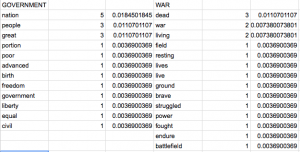Are computers able to read emotion? This is a very important question that we deal with when talking about topic modeling and digital sentiment analysis. What makes our brains, which are often compared to computers, able to read this emotion?
I do not think that computers can read emotions. They can be taught, however, to associate certain words with certain emotions. This is simply a computer reading an algorithm that is made for it to organize words in to categories. As more and more people take to the internet to express sentiment, whether it be via blog or twitter, digital analysis of sentiment has become an increasingly hot topic. Ramsey calls this a shift from a “cold arbiter of numerical facts” to a “platform for social networking and self-expression.” I think that this change in use of computers has definitely led to more efforts to have computers analyze emotions.
Topic Modeling and Emotion
Topic Modeling can play a big role when it comes to sentiment analysis via computer. Topic Modeling searches for patterns in texts and tries to organize a larger text into the topics that it is about. This can lead to discoveries about the sentiment of the text. Topic Modeling works best when the person using it is familiar with the text that is being analyzed so that the results make more sense and can be interpreted correctly. When we did our own Topic Modeling on the Gettysburg Address, we all came out with different results. We all chose different words for each topic and this was because of the different backgrounds that we all had and ways that we associated words with each topic.

This is a screen shot of the words that I chose that I thought represented both war and government in the Gettysburg address. As I was doing this, I realized how hard it would be for a computer to perform this task accurately. There are many words that cannot be associated with a certain topic without context. The algorithms that need to be used to create a perfectly accurate topic model would need to be very in depth and I do not think that they would be able to account for everything especially not from culture to culture. This is why the experimenter needs to be familiar with their text so that false results can be understood.
Ramsey says, “Such numbers are seldom meaningful without context, but they invite us into contexts that are possible only with digital tools.” We are able to use the digital text analysis tools that we have to discover things like patterns and frequencies in texts, but I do not think that we are able to read emotions accurately through digital analysis.